1996 CADILLAC ELDORADO radiator cap
[x] Cancel search: radiator capPage 243 of 354
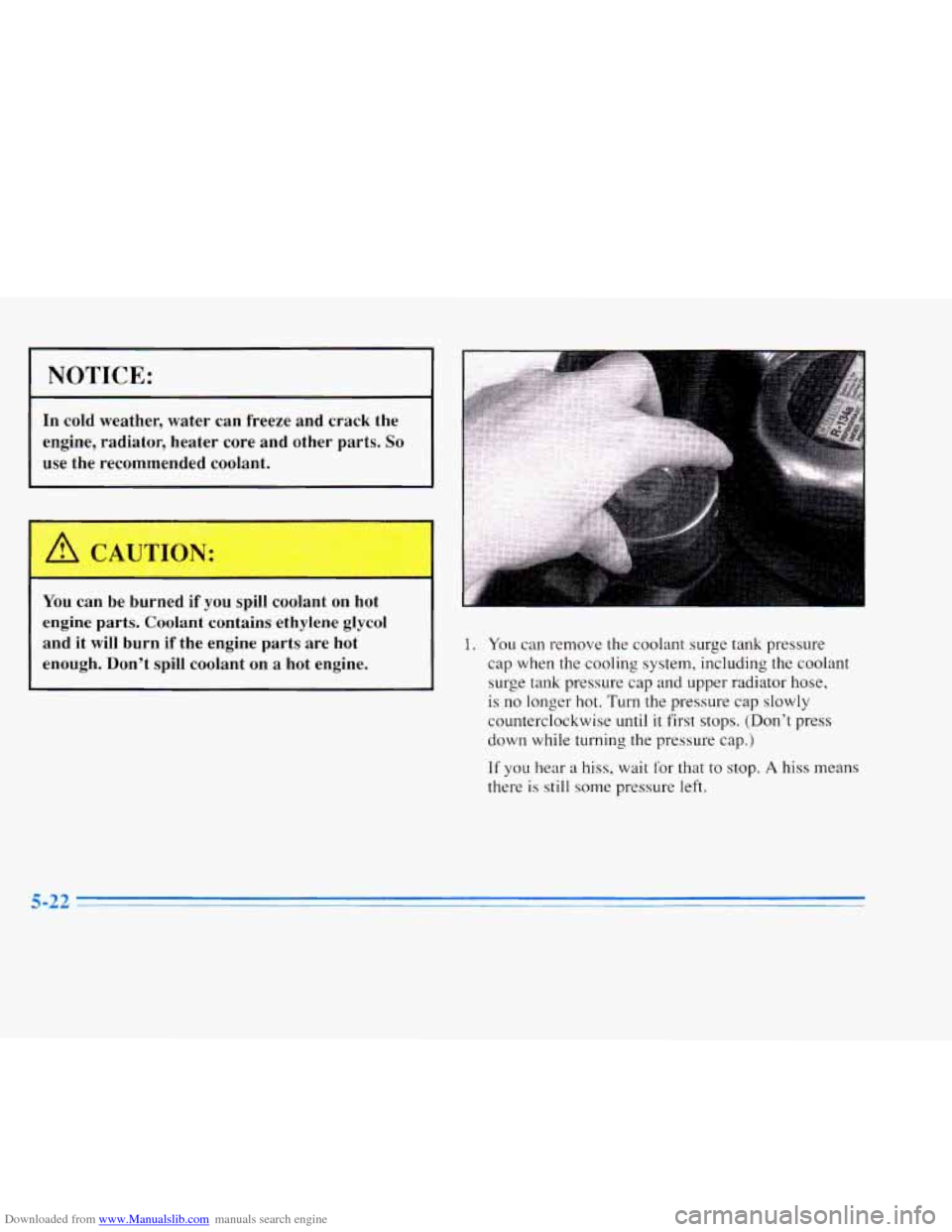
Downloaded from www.Manualslib.com manuals search engine NOTICE:
In cold weather, water can freeze and crack the
engine, radiator, heater core and other parts.
So
use the recommended coolant.
You can be burned if you spill coolant on hot
engine parts. Coolant contains ethylene
glycol
and it will burn if the engine parts are hot
enough. Don’t spill coolant on
a hot engine.
1. You can remove the coolant surge tank pressure
cap when the cooling system, including the coolant
surge tank pressure cap
and upper radiator hose,
is
no longer hot. Turn the pressure cap slowly
counterclockwise until
it first stops. (Don’t press
down while turning the pressure cap.)
If you hear a hiss, wait for that to stop. A hiss means
there is still some pressure left.
Page 245 of 354
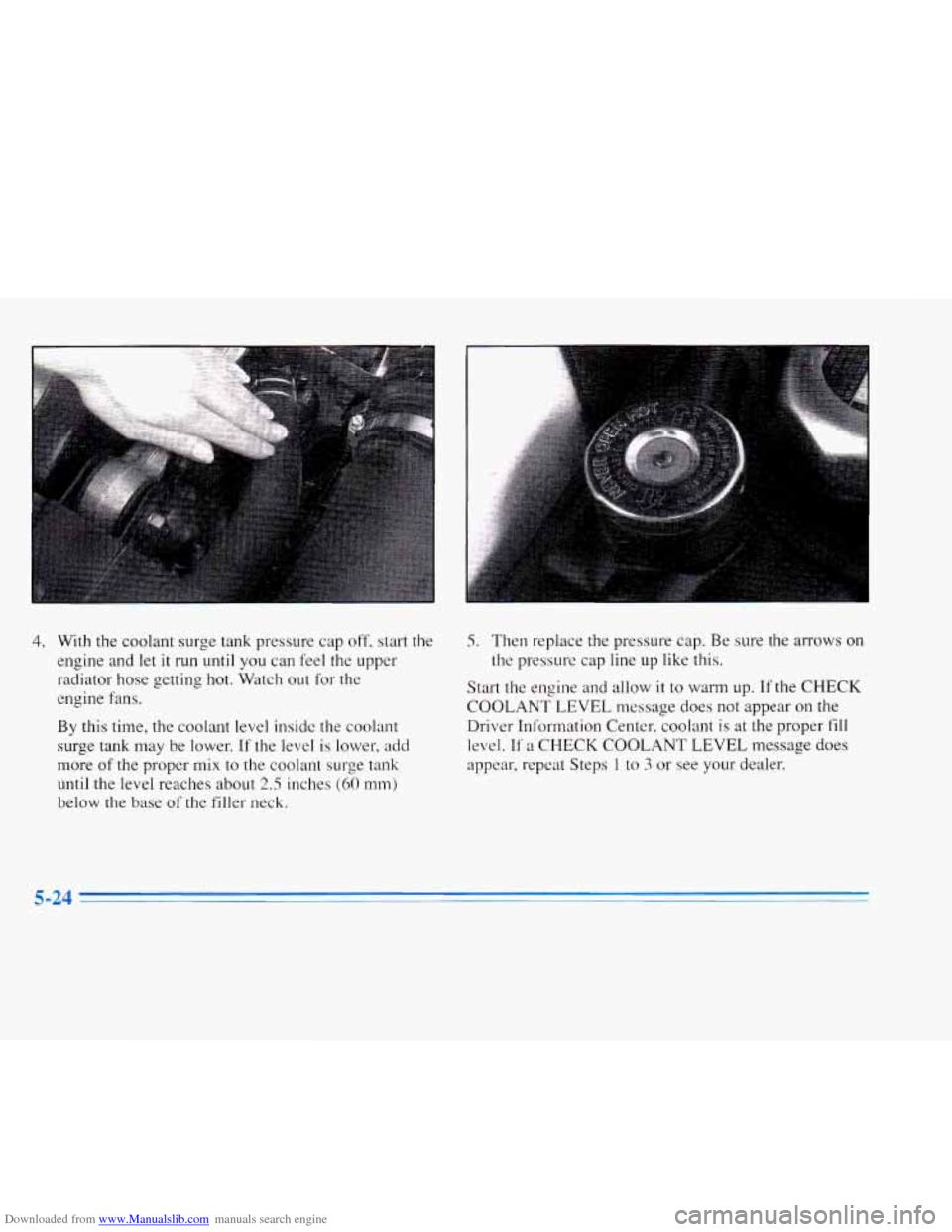
Downloaded from www.Manualslib.com manuals search engine 4. With the coolant surge tank pressure cap oft', start the 5. Then replace the pressure cap. Be sure the arrows on
engine and let it run until you can feel
the upper the pressure cap line up like this.
radiator hose getting hot. Watch out for the
engine fans.
By this time, the coolant level inside the coolant Driver Information Center, coolant
is at the proper fill
surge tank may be lower.
If the level is lower, add level. If a CHECK COOLANT LEVEL message does
more
of the proper mix to the coolant surge tank appear, repcat Steps 1 to 3 or see your dealer.
until the level reaches about
2.5 inches (60 mm)
below the base
of the filler neck. Start
the engine and allow
it to warm up. If the CHECK
COOLANT LEVEL message does not appear on the
Page 268 of 354
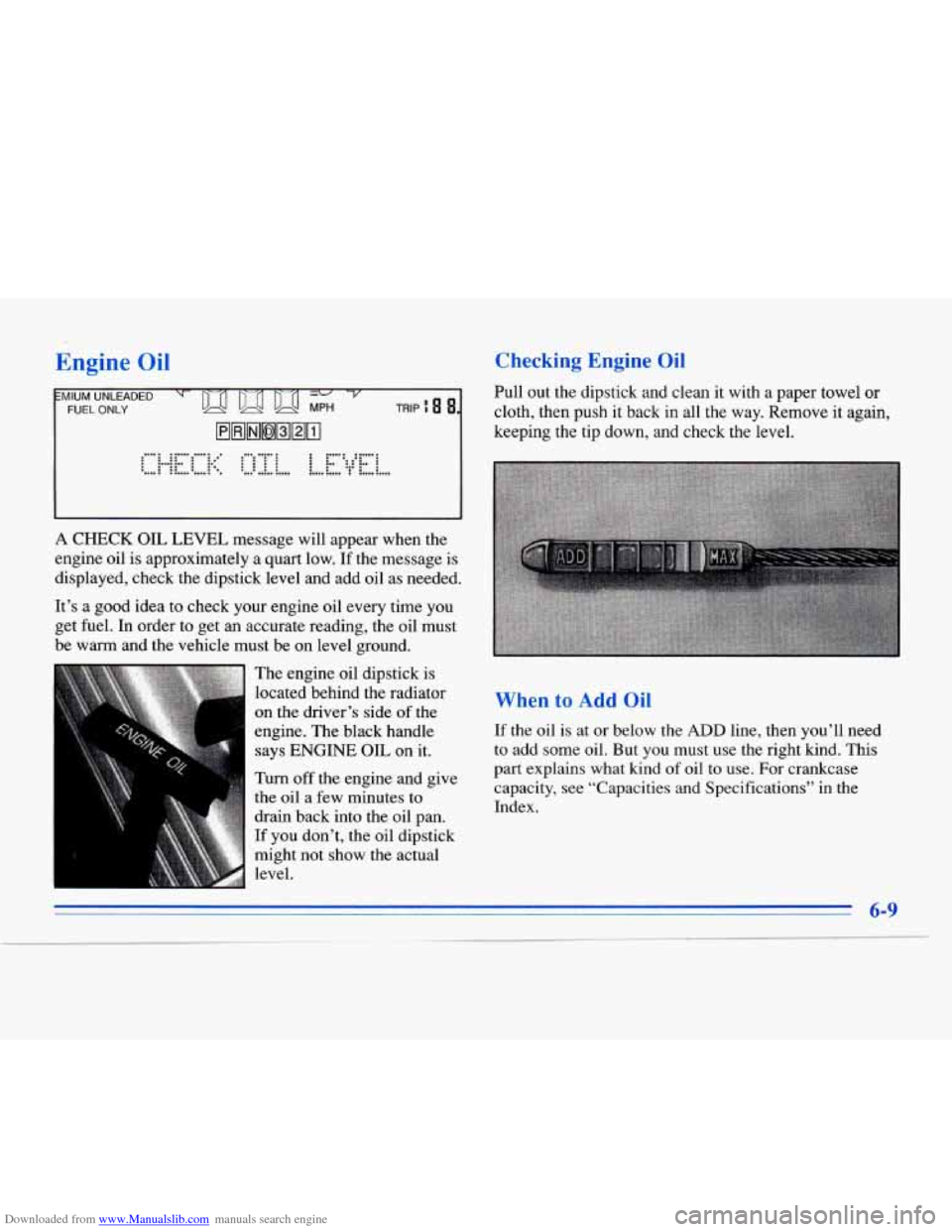
Downloaded from www.Manualslib.com manuals search engine e Oil
......... ............... . ........... ........... ...... ........... ...... .. .. ............ .... .......... ........... ....... ........... ..... ...................................................
A CHECK OIL LEVEL message will appear when the
engine oil is approximately a quart low. If the message is
displayed, check the dipstick level and add oil as needed.
It’s
a good idea to check your engine oil every time you
get fuel. In order to get an accurate reading, the oil must
be warm and the vehicle must be on level ground.
The engine oil dipstick is
located behind the radiator
on the driver’s side of the
engine. The black handle
says
ENGINE OIL on it.
Turn off the engine and give
the oil a few minutes to
drain back into the oil pan.
If you don’t, the oil dipstick
might not show the actual
level.
Checking Engine Oil
Pull out the dipstick and clean it with a paper towel or
cloth, then push it back in all the way. Remove it again,
keeping
the tip down, and check the level.
11 the oil is at or below the ADD line, then you’ll need
to add some oil. But you must use the right kind, This
part explains what kind of oil to use. For crankcase
capacity, see “Capacities
and Specifications’’ in the
Index.
6-9
Page 269 of 354

Downloaded from www.Manualslib.com manuals search engine ~ NOTICE:
~
Don’t add too much oil: If your engine has so
much oil that the oil level gets above the upper
mark that shows the proper operating range,
your engine could be damaged.
I
The oil fill
cap is located
behind the radiator on the
passenger’s side of the
engine.
Turn the cap
counterclockwise to
remove.
’ Just fill it enough to put’the level somewhere in the
proper operating range. Push the dipstick all the way
back
ip when you’re through.
What’Kind of Oil to Use
Oils recommended for your vehicle can be identified by
looking for the “Starburst” symbol. This symbol
indicates that the oil has been certified by the American
Petroleum Institute
(API). Do not use any oil which
does not carry this Starburst symbol.
’
- If you change your own oil,
be sure you use oil that has
the Starburst symbol on the
front of the oil container. If
you have your oil changed
for you, be sure the
oil put
into your engine is American Petroleum
Institute certified for
gasoline engines.
You should also use the proper viscosity oil for your
vehicle, as shown in the following’chart:
6-10
Page 276 of 354

Downloaded from www.Manualslib.com manuals search engine To get the right reading, the fluid should be at normal
operating temperature, which is
180" F to 200" F
(82°C to 93°C).
Get the vehicle warmed up by driving about 15 miles
(24 km) when outside temperatures are above 50°F
(10°C). If it's colder than 50°F (lO"C), you may have
to drive longer.
C hec 1 the Fluid Le7
Park your vehicle on a level place. Keep the engine
running.
With the parking brake applied, place the shift lever
in PARK
(P).
With your foot on the brake pedal, move the shift
lever through each gear range, pausing for about
three seconds in each range. Then, position the shift
lever in PARK (P).
Let the engine run at idle for three to five minutes.
Then, without shutting
off the engine, follow these steps: The
black transaxle fluid cap is located next to the
radiator hose and below the air cleaner assembly on
the driver's side of the engine. Remove the air
cleaner assembly
so you can reach the transaxle fluid
cap. The assembly
is attached to the vehicle by two
fasteners. Simply lift up on the air cleaner assembly
to remove
it. Find the transaxle fluid cap and turn it
counterclockwise to remove. Pull out the dipstick
and wipe
it with a clean rag or paper towel.
Push it back in all the way, wait three seconds and
then pull
it back out again.
1.
2.
Page 280 of 354

Downloaded from www.Manualslib.com manuals search engine Checking Coolant
The surge tank is located next to the engine block on the
passenger’s side of the engine.
The cooling system when hot is under
a lot of pressure.
If the CHECK COOLANT LEVEL message appears on
the
DIC, you will need to add coolant.
A CAUTION:
I
I
lhrning the surge tank pressure cap when the
engine and radiator are hot can allow steam and
scalding liquids
to blow out and burn you badly.
Never turn the surge tank pressure cap
-- even a
little
-- when the engine and radiator are hot.
When your engine is cold, the coolant level should be at
the full cold mark, which is
2.5 inches (60 mm) below
the base
of the fill neck. Use a flashlight as necessary to
see into the tank..
6-21
Page 282 of 354
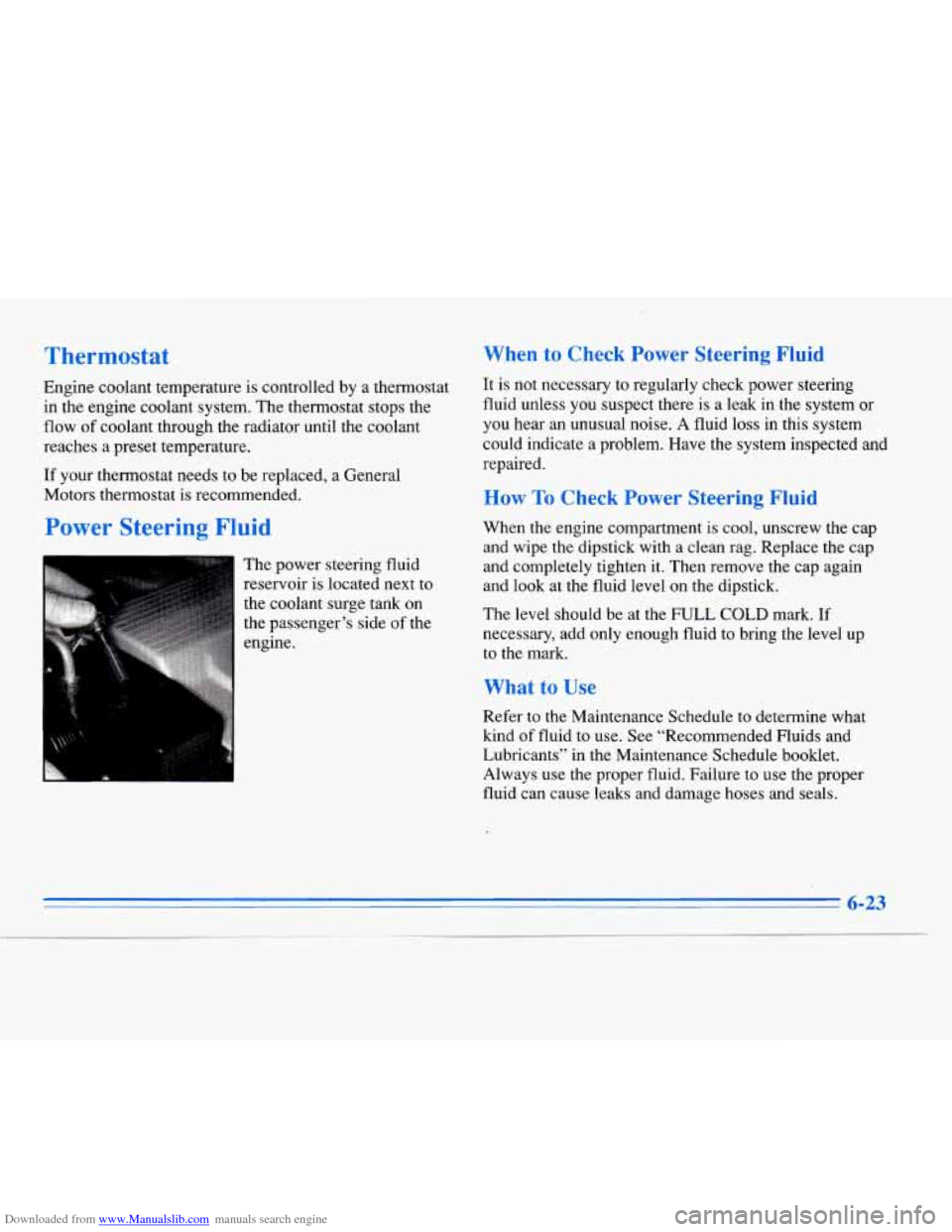
Downloaded from www.Manualslib.com manuals search engine Thermostat
Engine coolant temperature is controlled by a thermostat
in the engine coolant system. The thermostat stops the
flow of coolant through the radiator until the coolant
reaches a preset temperature.
If your thermostat needs to be replaced, a General
Motors thermostat is recommended.
Power Steering Fluid
The power steering fluid
reservoir is located next to
the coolant surge tank on
the passenger’s side of the
engine.
When to Check Power Steering Fluid
It is not necessary to regularly check power steering
fluid unless you suspect there is a leak in the system or
you hear an unusual noise. A fluid loss in this system
could indicate a problem. Have the system inspected and
repaired.
How To Check Power Steering Fluid
When the engine compartment is cool, unscrew the cap
and wipe the dipstick with a clean rag. Replace the cap
and completely tighten
it. Then remove the cap again
and look at the fluid level on the dipstick.
The level should be at the FULL
COLD mark. If
necessary, add only enough fluid to bring the level up
to the mark.
What to Use
Refer to the Maintenance Schedule to determine what
kind of fluid to use. See “Recommended Fluids and
Lubricants” in the Maintenance Schedule booklet.
Always use the proper fluid. Failure to use the proper
fluid can cause leaks and damage hoses and seals.
6-23
Page 283 of 354
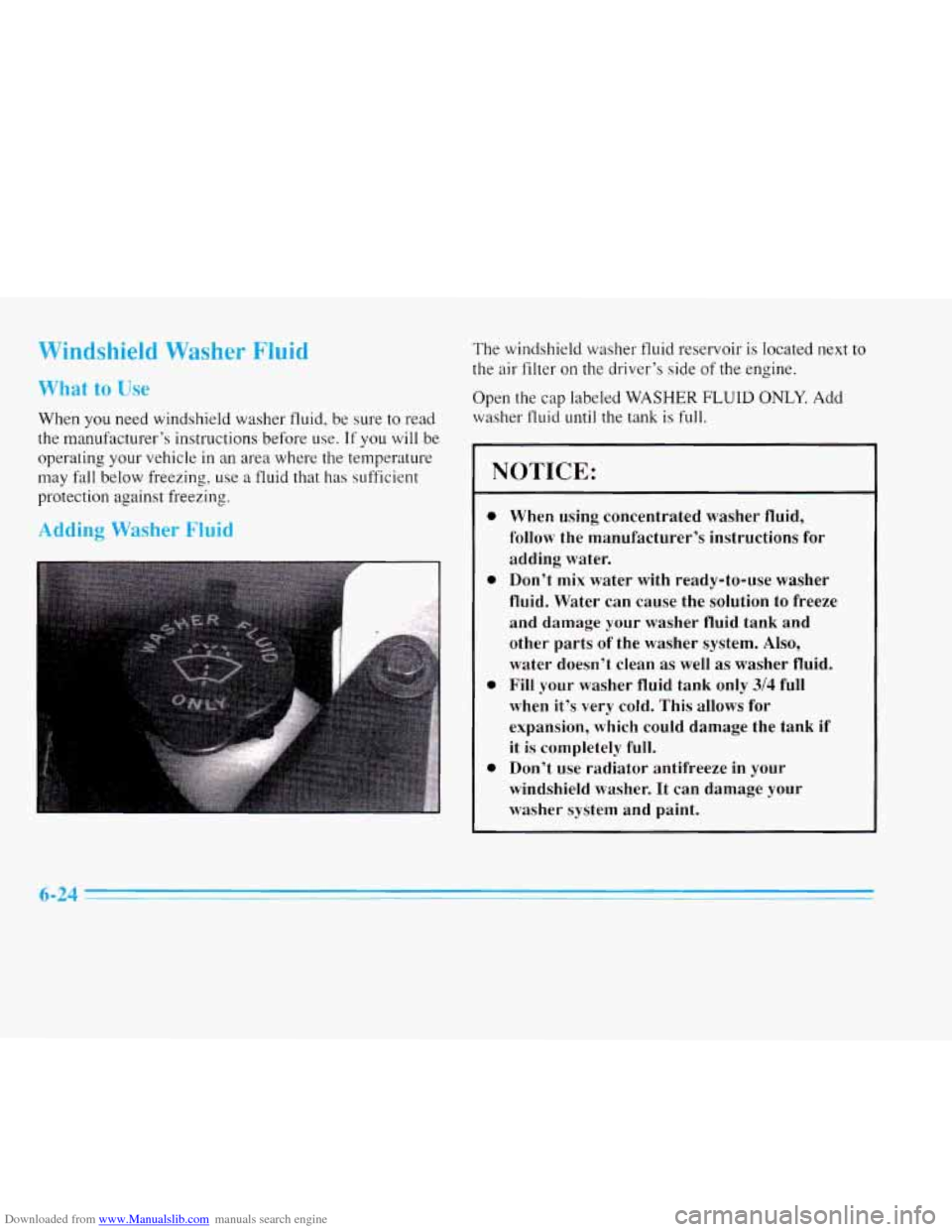
Downloaded from www.Manualslib.com manuals search engine Windshield Washer Fluid
What to Use
When you need windshield washer fluid, be sure to read
the manufact.urer’s instructions before use.
If you will be
operating your vehicle in an area where the temperature
may fall below freezing, use
a fluid that has sufficient
protection against freezing.
idding Washer Fluid
The windshield washer tluid reservoir is located next to
the air filter on the driver’s side of the engine.
Open the cap labeled
WASHER FLUID ONLY. Add
washer
fluid until the tank is full.
NOTICE:
a
a
a When using concentrated washer fluid,
follow the manufacturer’s instructions
for
adding water.
Don’t mix water with ready-to-use washer
fluid. Water can cause the solution to
freeze
and damage your washer fluid tank and
other parts of the washer system.
Also,
water doesn’t clean as well as washer fluid.
Fill your washer fluid tank only 3/4 full
when it’s very cold. This allows
for
expansion, which could damage the tank if
it
is completely full.
Don’t
use radiator antifreeze in your
windshield washer. It can damage your
washer system and paint.
6-24